

CAA Continuing Professional Development Programme
Event: Unlocking Opportunities in Green Building with EDGE Certification (Session 1)
Post-Event Attendance & Feedback Report
This event was held in collaboration with
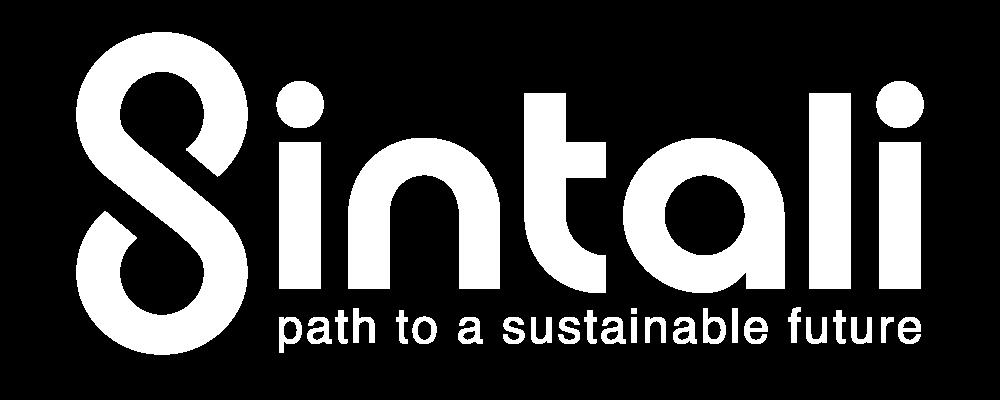
Date Issued: 10 August 2025
1.
2.
Executive Summary
The following document has been prepared for CAA Council to report on the attendance, feedback and promotion strategies for the second session of the 2024-2026 season of the Continuing Professional Development (CPD) programme. This particular session is part of a collaboration between the CAA and Sintali focusing in particular on the opportunities associated with Excellence in Design for Greater Efficiencies (EDGE) Certification and is the first session as part of a three-part collaborative series with Sintali. Session 2, focusing on the use and function of the EDGE Certification software will be held in July 2025 and session 3, focusing on EDGE Expert training will be held directly by Sintali through a paid, on-demand service to participants. This event was held online on Thursday, 25th June 2025.
The objective of this session was to introduce attendees to the EDGE Certification (Excellence in Design for Greater Efficiencies) system. The session provided an overview EDGE Certification benefits, focusing in particular on how it unlocks opportunities in green financing to encourage sustainable development. Attendees heard from consultant practitioners (EDGE Experts) who outlined how they have successfully integrated EDGE expertise into their consultant practices to support architecture, construction and design across the Commonwealth to facilitate sustainable urbanisation and development.
In terms of attendance:
- Total number of registered participants: 245
- Total number of unique viewers: 137
- Maximum number of concurrent views: 106
Of the 137 unique viewers at the event, a total of 122 participants, or 90% of attendees were present for at least 30 minutes (half) of the session, which qualifies them for the CPD Certificate for the event. The 90% attendance rate represents the highest record of audience retention for our events since October 2024, when records began and suggests that audience engagement for the full duration of the session was successfully maintained and continues to increase as the CAA continues to refine the structure and approach for these sessions.
Feedback on the CAA collaboration with Sintali was evidently positive. A majority of postevent survey respondents (76%) indicated that they were interested in pursuing the EDGE Certification programme with Sintali and a further 22% indicating they were ‘maybe’ interested. Written feedback on the session also showed interest in participation for Session 2 of the collaboration with Sintali which is scheduled for July 2025 and will feature a deep dive into the day-to-day operation of the EDGE App and the process for becoming accredited as an EDGE Expert through SIntali.
In surveying the valid responses to CPD learning questions and feedback responses, it was evident that the specialised event supported by Sintali and EDGE Experts helped to ensure that learning was immediately and actively engaging for attendees. The CPD learning responses (anonymised) showed generally consistent responses which aligned both to speaker presentations and the learning outcomes for the event.
As a mark of the programme’s ongoing success, feedback on the event has been overwhelmingly positive. Responses indicated that:
- 98% found the presenter(s) to be engaging.
- 100% found the event to be well organised.
- 93% found the event to be just the right amount of time.
- 85% of attendees were architects or practitioners of architecture.
- 100% would like to see the CAA CPD programme continue.
Nevertheless, this report highlights that there are still areas for improvement, namely that:
- 71% of respondents felt that there needed to be more time for engagement with the speakers (i.e. more time for Q&A). A similar result and comment was presented in the most recent session of the CAA CPD event featuring Prof. Yasmeen Lari in early-June 2025.
Feedback on the length of the session, since records began in October 2024 show that the current session timing is ideal for the vast majority of respondents. An overwhelming 93% of responses indicated that the 1 hour 15 minute to 1 hour 30 minute session was ‘just right’ with only 7% indicating it was too long. There were no respondents who found the session to be ‘too short.’
Feedback from respondents overwhelmingly support the continuation of the CPD programme and in particular, seek more sessions on the following areas:
- Sustainability & Sustainable Projects (i.e. Case study focus)
- Materials and Construction Methods including Energy Efficiency in Design
- Artificial Intelligence and Impact upon Architectural Practice & Profession
In view of the feedback and to build on the continued success of the CPD Programme, the following areas of observation and improvement are suggested:
1. Promotional Strategies
a. Continued refinement and standardisation of the CAA CPD programme’s media strategy to diversify our outreach beyond the CAA Newsletter.
b. Greater collaborative work with communication and media teams from the various Institutes of Architecture so that events can be more directly promoted to our partners.
c. Ensure that all Regional Vice-presidents on Council receive CPD updates and information in a timely manner for distribution to respective networks to encourage higher participation and sign-up.
2. Attendance Retention & Audience Retention
a. Continue to use a component of newsletter reminders to serve as ‘reminders’ to ensure that all registrations are used, as it is noted that a persistently high number of registrants are ‘non-attendees.’
b. Continued development of the Microsoft Forms integration for feedback and CPD participation, encouraging attendees to complete the learning reflection questions to ensure that they have the opportunity to put their knowledge in practice rather than simply listen as passive observers.
c. develop a component of newsletter or social media outreach to serve as ‘reminders’ to ensure that all registrations are used, and a larger portion of registered attendees will commit to actually attending. This has been observed as an ongoing trend that only about 50% of registered attendees attend events on the day.
3. Feedback Monitoring
a. Continue to maintain consistent feedback sheets and questions to ensure that trend-mapping to monitor the CPD programme, enhance and review success of the programme can be undertaken.
Unfortunately, whilst I was personally unable to moderate this session in collaboration with Sintali, I was able to attend as an observer for the duration of the event. I would like to extend particular thanks to fellow Council member, Peter Oborn, Immediate Past President, who has been a pillar of support for the CPD programme and who stepped in to serve as moderator for this event. With over 25% of respondents interested in furthering their learning with Sintali, I look forward to the detailed session on the EDGE Certification application in July 2025, as well as the potential opportunities for upskilling a new generation of EDGE Experts in collaboration with Sintali in the near future.
Hugo Chan Youth Representative Commonwealth Association of Architects
CPD Event Objective
The objective of this session is to introduce attendees to the EDGE Certification (Excellence in Design for Greater Efficiencies) system. The session will provide an overview on the benefits of EDGE Certification, focusing in particular on how it unlocks opportunities in green financing to encourage sustainable development. Attendees will hear from three consultant practitioners (EDGE Experts) who will highlight how they have successfully integrated EDGE expertise into their consultant practices to support architecture, construction and design across the Commonwealth to facilitate sustainable urbanisation and development.
Learning Outcomes for Attendees
The sessions learning outcomes were to be able to:
1. Be introduced to the EDGE (Excellence in Design for Greater Efficiencies) Certification system, including its underpinning principles, the metrics measured in determining sustainable performance outcomes for a project and the benefits of using EDGE Certification.
2. Be introduced to the importance of ‘Green Financing’ and how the use of EDGE Certification and demonstration of tangible financial benefits of green building and high-performance building can lead to better environmental and financial outcomes for developers, unlocking opportunities for green financing to encourage sustainable development.
3. Understand how EDGE Certification may be integrated into an existing architectural / design / construction business or consultancy through engagement with real-world professionals, to examine how EDGE Certification may provide new opportunities for business growth and diversification.
Participant Reflection
As part of attendee’s reflections, five learning questions were asked:
1. Which three factors does EDGE Certification focus on?
2. Name one reason why a developer might choose to certify with EDGE.
3. What is the role of an EDGE Expert?
4. Name one of the success factors for Inside Out Consulting for building a business with EDGE Certification.
5. What do you see as a key challenge in your home country or practice environment which is preventing further progress towards ecologically sustainable development and achievement of the Sustainable Development Goals (SDGs)?
An anonymised and randomised data record (to protect individual response privacy) has been supplied in Appendices A – E of this report, detailing the valid responses received by some participants. Only valid and complete responses are shown in these appendices and minor editing to correct grammar, spelling, punctuation and formatting have been undertaken.
With respect to participant reflections, the following positive observations were noted:
- It was noted that approximately 25% of responses from attendees (43 out of 163) were received, showing a good level of engagement with the participant reflection and CPD questions. Note that completion of the reflection online is not mandatory and attendees have the option of downloading the learning sheet questions for their own reflection if preferred.
- The responses were generally reflective of the content presented in the session, suggesting that attendees were engaged in the session and were genuinely interested in learning and reflect on their learning.
- The summaries received from attendees is also demonstrative of the clarity and precision of the presenters’ sessions, showing that the event was easy to understand, educational and engaging.
- The responses also showed that attendees were thinking critically and engaging with the course content and materials.
Principal Contributors
Through the generous support of Sintali and their network of global EDGE Experts, four presenters provided an overview of the EDGE Certification system as well as providing context to how the rating scheme was successfully applied in their Commonwealth region. For this session, we were fortunate to have had examples from the Asia and Africa Regions of the Commonwealth.
Ms. Julia Evans (Presenter) Sintali
Mr. Ashu Gupta (Presenter) Design2Occupancy
Mr. Amrish Shah (Presenter) Urban Green Consultants
Ms. Yvonne Pelser (Presenter) InsideOut Consulting
Mr. Peter Oborn (Moderator) Immediate Past President, CAA
Mr. Jacob Mwangi (Technical Coordination) Executive Director, CAA
Mr. Asim Jalal (Technical Coordination) IT Coordinator, CAA
Recording – Online Platform
A digital recording of the event has now been prepared and will be made accessible to the public via our website.
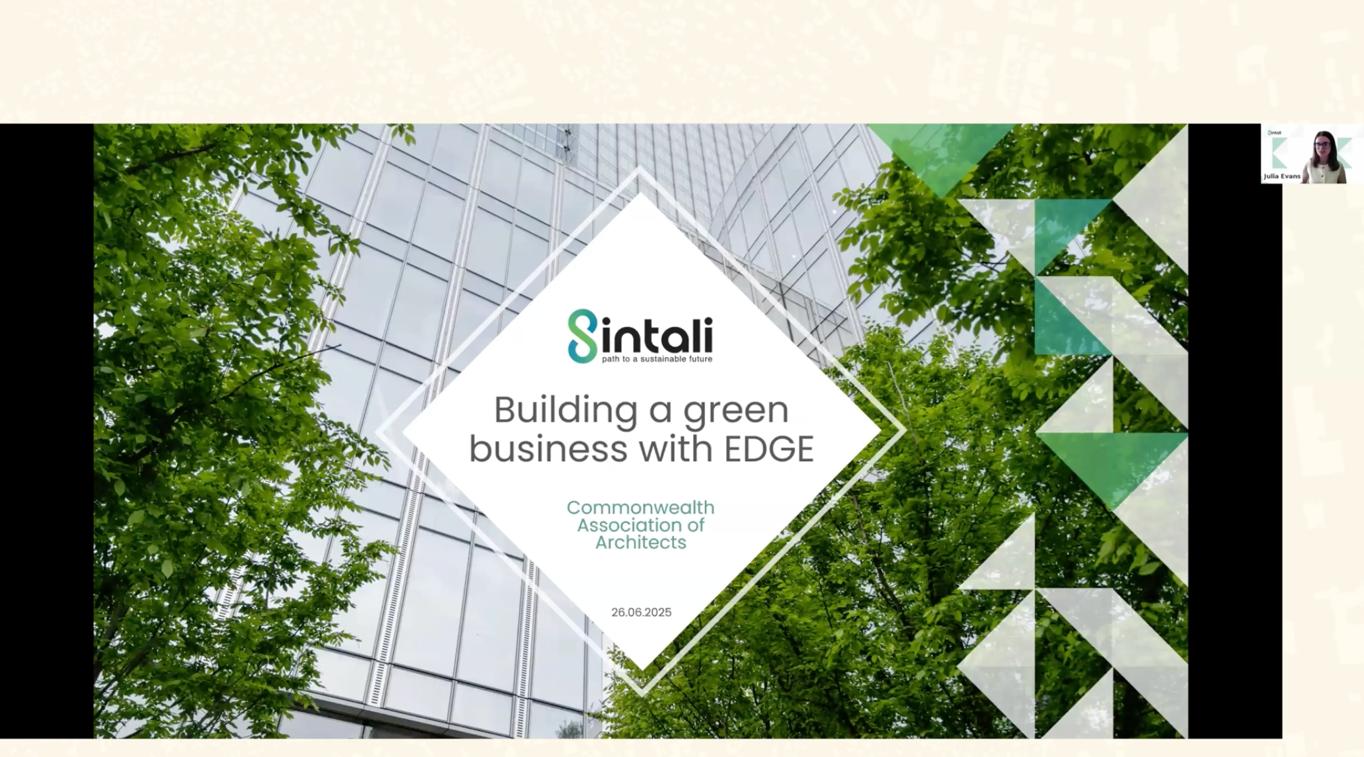
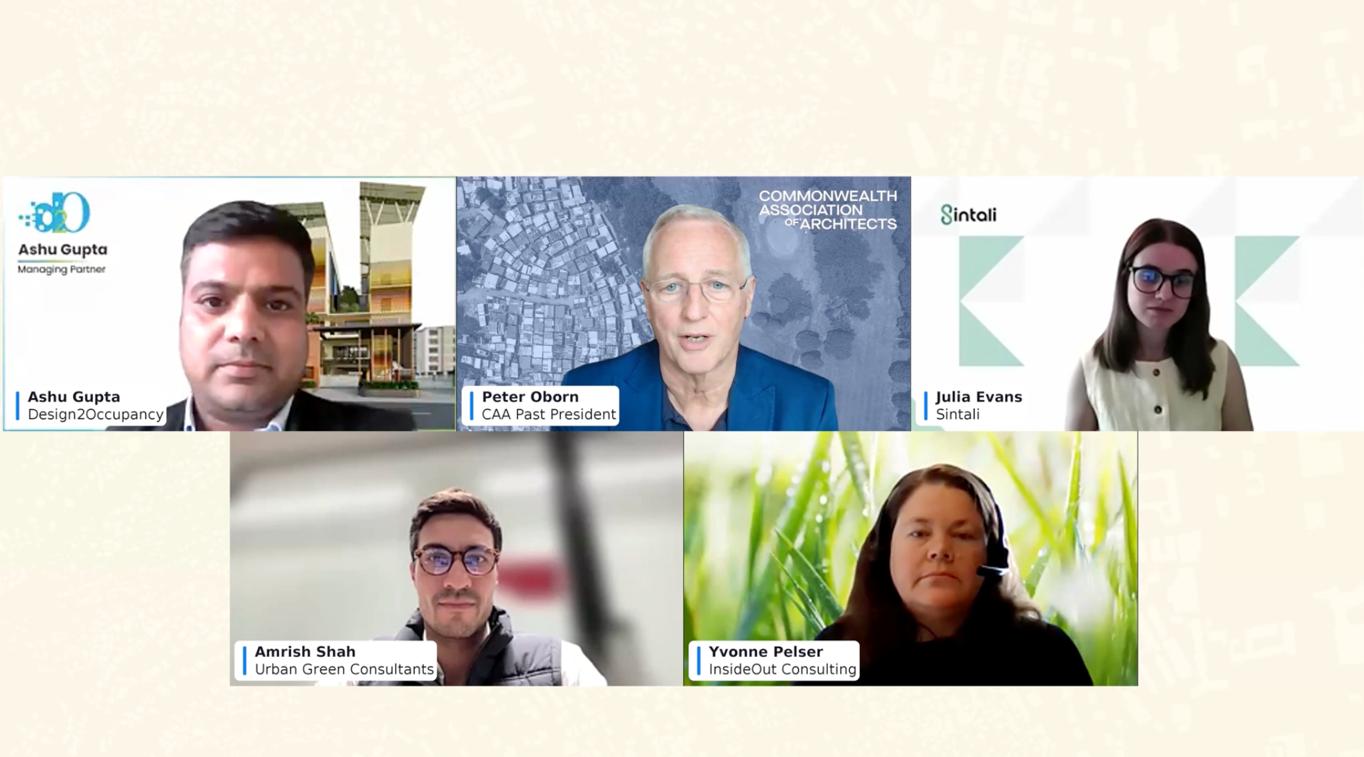
1. Still Image from ZOOM Recording during the Lecture by Sintali.
2 Still Image from ZOOM Recording during the Question & Answer Session featuring Sintali and EDGE Experts for the session, moderated by Immediate Past President, Peter Oborn.
Event Promotion
As part of an ongoing review of social media strategies, a number of additional event promotion methods were adopted, in addition to the standard CAA CPD Newsletter. The following strategies were used in aid of promoting the event:
- CAA CPD Newsletter
- Sintali Collaboration Social Media
In the subsequent sections, a brief review of the event promotion strategies is considered, alongside broad comments on potential adjustments to increase interest and registration numbers.
CAA CPD Newsletter
Two principal newsletters were issued to registered newsletter recipients for this CPD event, alongside follow-up resends. The first newsletter was sent on 17 June 2025, with targeted supplementary emails re-sent 24-48 hours later to individuals who did not open this email. A second newsletter was issued on 23 June 2025, two days prior to the event. For this event, there were a total of 1,300+ emails registered. A record of the newsletter is in Appendix A .
Newsletter 1 – 17 June 2025
- The newsletter was successfully sent out to 1,351 emails, representing an increase in subscriptions from 1,317.
- Of this, 27.4% or 367 emails were opened. This is a decline our previous newsletters which typically average 45% open rate.
- Despite the low open rate however, it was good to note that 79% or 179 persons clicked through to register via the ZOOM link. This is substantially higher than our typical click through rate of 10% - 15%.
Newsletter 2 – 23 June 2025
- The newsletter was successfully sent out to 1,341 emails
- Of this, 26% of emails (346) were opened, slightly down from the previous session of 38.8% .
- Of this, 64.9% or 72 persons clicked the link to register, substantially higher than the previous 7.7% click rate from our previous event.
Analysis
These values are placed in comparison to our last CPD event held in October 2024 (the previous Council):
Newsletter 1 – 23 October 2024
- The newsletter was successfully sent out to 1,293 emails, representing 97% of registered emails.
- Of this, 62% or, 807 emails were opened.
- Of this 12% or, 151 persons clicked to register on the ZOOM link provided.
Newsletter 2 – 29 October 2024
- The newsletter was successfully sent out to 1,295 emails, representing 97% of registered emails.
- Of this, 51% or, 656 emails were opened.
- Of this 6.2% or, 80 persons clicked to register on the ZOOM link provided.
In view of this in comparison to the most recent newsletter campaign, it is concluded that the newsletter readership and click-rate is comparable, indicating that a degree of interest is being maintained.
It would be appropriate to discuss in due course however, whether there are ways of improving the newsletter structure in terms of its visual interest and simplicity to improve click-rates and registrations.
The social media Following of the CAA on LinkedIn continues to grow steadily and for this event, a series of posts were used to highlight the event. At the time of this event, the number of followers of the CAA on LinkedIn was between 500 – 650 persons. A total of four posts, comprising the posters and Instagram posts were used on this platform and on average, garnering a total of over 1,000 ‘organic ’ views. Engagement involved linking as well as a number of shares by other persons to their own networks, including a specialised post prepared by Sintali (co-host for the event) and D2Occupancy, one of the presenter organisations. Overall, the continued social media presence on LinkedIn remains important, and it was noted in feedback that 12% of individuals heard about the event via this channel, showing growth from the last session (7%).
The event was shared on Facebook and pinned (in the leadup) to the event. The post was noted as being liked by multiple persons as well as being shared by two Individuals.
X (formerly Twitter)
For this particular event due to minor technical delays, no posts on X (Twitter) were publicised for the event.
The CAA Instagram account, launched in October 2024 has now grown to just over 300 followers and events are strongly supported through sharing and views on the platform and via the ‘stories’ function. For this event, one post was shared, garnering 327 views and 4 shares to other news and organisation channels. This shows an ongoing natural growth of the platform as a major potential source for highlighting events. Instagram is also being used by a number of our member institutes in ‘resharing’ news of the event to their members, showing important and continued presence on this platform will be important.
ArchDaily
Due to time constraints in preparing for this event, no submission on ArchDaily was made for this particular session.
Summary of Findings – Promotion Strategy
To garner additional information on the promotion of CPD events, an additional survey question was added to ask attendees where they heard about the event and from what source. Preliminary data notes that a majority (47%) of registered attendees registered for the event via the CAA Newsletter, which remains our most direct and effective way of outreach to member individuals.
It is important to note that the diversification of our marketing and communications strategy has started to prove effective and will continue to be important in raising awareness of the CPD programme. It was noted that:
- 12% found the event via LinkedIn
- 2% found the event via Facebook
- 5% found the event via Instagram
The data highlights the importance of diversifying our outreach. Continued engagement via social media as well as setting up of regular emails for Regional Vice-Presidents to share news of upcoming events, both via the newsletter and standardised templates (press releases) will be important in growing the attendance for future CPD events.
Overall, noting that both the Instagram and LinkedIn accounts for CAA are less than a year old, that they have been able to direct a non-unsubstantial number of attendees toward our events is indicative of how a diversified social media strategy will form a pillar of promotion in the CAA’s continued efforts.
Attendance Breakdown
Number of Attendees
Summary
- Total number of registered participants: 245
- Total number of unique viewers: 137
- Maximum number of concurrent views: 106
Additional information:
- 110 participants were registered to attend but did not attend. (45% of registrations)
- 122 participants were present for 30 minutes or more – qualifying for the Certificate of Participation (50% of all registrants)
Analysis:
- The event was one of the most successful events in terms of maintaining attendee presence in the session, with 90% of attendees qualifying for the certificate (attended for more than half the session). Thus, whilst the total registrations has declined from previous sessions, the high audience retention of those who did attend suggests that both the topic, content and presentation was engaging and successful in sustaining audience presence for the duration of the event.
- As mentioned in previous reports, there continue to be attendees who join in different intervals. This has been attributed to technical and internet connectivity issues. Consolidation of individual times to ensure that all attendees who cumulatively attend for more than half the session receives the certificate of participation.
- A continuing issue remains with a number of individuals who elect to register to attend, but who subsequently decide to not attend remains high but was on the decline for this event.
Attendance Summary
Attended (Short-Period)
Attended (Certificate)
As the sessions have progressed, there is an emerging trend over the period since this Season of events has commenced. Attendance rates have broadly been stable at upwards of 100 persons. Whilst slightly lower than previous events, there remains a strong degree of participation across the Commonwealth community.
Unlike previous CAA events, it was also positive to note that there has been a narrowing between the total number of registrations and the number of attendees. A total of 245 registrations were recorded for this event, with 137 attendees, representing an attendance rate of over 50%. This is juxtaposed against the Lifetime Achievement Award presentations which saw 489 registrations but only 163 attendees, or 33%.
Noting that current ZOOM subscription limits our attendance to 500 attendees, continued efforts to ‘close the gap’ between those who register and those who do not attend should be maintained. In the long term, reminder emails (autogenerated) should be sent to advise attendees to ‘opt-out’ or ‘deregister’ if they do not attend so that sufficient space for attendees can be maintained.
of Individuals Registration & Attendance Numbers
As previously stated, of the 137 attendees, 122 persons qualified for the Certificate of Participation equating to an active retention rate of 90%. This represents one of our highest event retention rates and our co-hosts, Sintali, as well as the EDGE Expert presenters must be commended for their work in delivering an informative and engaging presentation which enabled this high level of participation.
Professional Background
It was noted that the vast majority of attendees identified as architects. Compared to the previous event, a growing number of individuals identified themselves as academics and/or researchers and several architecture adjacent professionals (engineers, quantity surveyors, urban designers) were also registered as attendees. In addition to this, several students of architecture were also in attendance, indicating that the CAA is slowly improving its outreach beyond the traditional core audience of architects, and enabling a more diverse cohort of architecture professionals to participate in our events.
Regions & Countries Represented
Similar to previous events, it is pleasing to report that representative attendance from all regions of the Commonwealth was found, including several countries from outside the Commonwealth. An overwhelming majority of individual attendees come from three principal regions: Africa (39%), Asia (31%) and Caribbean & Americas (17%). These three regions have consistently been our highest attendee regions.
Regional
Representation of
Attendance
5 Chart – Regional Representation of Attendance
The table on the subsequent page provides a detailed breakdown of the attendees separated by nations. Note that attendees outside the Commonwealth are denoted by the asterisk ‘*’ for reference. It was noted that 124 of the participants were recorded as being from the Commonwealth (91%) and 13 were registered outside (9%). The attendees hailed from 33 different nations and regions, indicating that we currently have attendance from nearly two-thirds of all Commonwealth countries
Event Feedback
Feedback on the event has been overwhelmingly positive. There were a total of 43 survey respondents received within the first week after the event, representing approximately 27% of total unique viewers (163). Out of these responses:
- 100% found the event was of interest
- 100% found the event to be well managed.
- 93% found the event to be just the right amount of time
- 100% would like to see the CAA CPD programme continue.
In comparison with previous sessions concerning the management, the following observations were made:
- 71% of respondents felt that there needed to be more time for engagement with the speakers (i.e. more time for Q&A). This still remains comparable to recent sessions where this question has monitored (66% & 85% for two previous events). This response indicates that there may need to be further adjustments to provide longer Q&A periods in CPD events and sessions.
- 7% of respondents found that the session was too long, an inversion of the previous session where 7% of respondents found the session to be too short. It is worth noting that this session had multiple presenters and was maintained at between 1hr15mins to 1hr30mins. The generally low level of concern on the event being ‘too long’ or ‘too short’ suggests that the current session timing and structure is generally acceptable to most attendees.
A review to responses on the question around ‘future topics’ was found to predominantly focus on ‘sustainability’, with comments being:
- How to Integrate EDGE Certification into Projects
- Case Study Learning – Understanding sustainability principles through specific projects.
- Retrofitting and conservation in architecture.
- RRRR – Reduce / Reuse / Recycle / Repair
Other, less conventional topic suggestions also included:
- Artificial Intelligence – Impact on design process and future of architecture
- Business of architecture and how to run a practice.
Concluding Observations
From the attendance information and feedback, the following observations with respect to our collaboration with Sintali were observed:
• It was noted that whilst attendance was smaller than recent events at 135 persons, as a testament to the successful engagement of audiences, 122 or 90% of attendees stayed for the duration of the event, our highest audience retention rate since records began, indicating a high level of interest in the event and knowledge to be gained. This suggests that events which provide opportunities for professionally accredited training is a welcome and informative niche for future events and future collaboration opportunities with Sintali, as opposed to our general sessions and learning series.
• There is an opportunity to regularly review this series as a means of promoting the EDGE Certification system across the Commonwealth, as part of our commitment to upskilling architects and designers in climate literacy, and the CAA would welcome the opportunity to transform this series into a possible regular annual collaboration with Sintali, focusing over time, on different aspects of EDGE Certification, the work of Sintali and training more generally.
From the attendance information and feedback, the following observations with identified areas of improvement and further development to continue to build on the success of the CPD programme is made:
1. Thematic Engagement
• Sustainability continues to be a principal theme which audiences request CPD sessions on, across various topics.
• Noting the release of the CAA Practice Library and new website, there is an opportunity to strengthen our ‘case-study’ focus events, potentially by hosting future regional ‘sustainability’ deep dives featuring speakers from our good practice library.
• A few additional ‘new’ topics should be considered for the 2026 programme, particularly around new technologies and how it may impact the profession, such as Artificial Intelligence. Commitments to diversity and inclusion – such as accessible design principles and their impacts in terms of achieving the SDGs should also be considered as future topics.
2. Promotional Strategy Enhancement
• Continued refinement of our social media strategy is critical to the ongoing success of the CPD Programme.
• Continued growth of our media presence on LinkedIn and Instagram principally will be important in building support of both professionals and a younger audience.
• Continued engagement of National Institutes of Architecture – and their promotion of CAA events via their social media networks is crucial. Thus, the ongoing support of Regional Vice-Presidents in promoting events and acting as a major communication conduit will be important. It is suggested that a template ‘press-release’ style media package for events should be issued to all regional vice-presidents in tandem with newsletters and other materials to facilitate this.
3. Attendance & Audience Retention
• Continued reminders to be worked into the CPD introduction to remind viewers that minimum half-attendance is required to ensure they comply with CPD requirements.
• Separate reminder in newsletters should be added to ensure that ‘spare seats’ on ZOOM are not wasted. It is noted that the 500 person ZOOM Assembly is purchased by CAA at great expense, and it is noted that this should be supplied to those who actually attend.
4. Continued Feedback Monitoring
• This report is an updated template from one previously supplied by Peter Oborn (Immediate Past President) for use as a template to monitor feedback.
• Ongoing development of a standardised template by Hugo Chan will continue as part of feedback monitoring strategies.
ID Which three factors does EDGE Certification focus on?
1 Carbon, energy, water
2 Energy, Water and Embodied CO2/Energy
3
Energy, water, and materials as the three key areas for evaluating a building's sustainability focusing on these three areas, EDGE aims to provide a practical and measurable way for buildings to reduce their environmental footprint and promote greater resource efficiency
4 Water Energy Materials
Energy Efficiency
5
Water Efficiency
Embodied Energy in Materials
6 Energy Use, Water Usage and Materials (embodied carbon)
7 Sustainability
8 Water, Energy and Materials (embodied carbon)
9 Sustainability, Net Zero & Eco-friendly
10 carbon water energy
11 energy, water consumption, and embodied carbon in materials
12 Energy, water and material Which enables the adoption of green architecture materials
13 ENERGY and WATER EFFICIENCY, Embodied Energy in materials
14
15
16
Energy efficiency, Water efficiency and Embodied energy in materials
Energy Efficiency
Water Efficiency
Material Efficiency
Energy Efficiency
Water Efficiency
Embodied Energy in Materials
17 Energy, Water and embodied Carbon reduction
18 Reduction in use of water, energy use and emissions from materials in buildings.
19 Energy efficiency, water efficiency and embodied carbon in material
20 Energy efficiency, Efficient water use and the sustainable use of materials to reduce embodied carbon
ID Which three factors does EDGE Certification focus on?
21 1. Energy Use Reduction 2. Water Use Reduction 3. Embodied Carbon in Materials Reduction
22 advocacy, capacity building and climate action
23 Retrofitting, Reporting & Decarbonization.
24 The reduction of embodied energy in buildings, reducing energy use and water consumption in buildings
25 Reducing energy use, water use, and embodied energy in materials (in the most cost-effective way).
26 Energy saving, water saving and CO2 saving
27 Edge certification focuses on strategies to reduce energy use, water use and embodied carbon in materials.
28 Water, Energy an Materials embodied Carbon
29 Energy, Water and Materials
30 Water, Energy, and Materials
31 Energy, Water and Materials
32 Green building
33 Water, Energy and Materials
34 energy saving, easy certificafication and material
35 EDGE Certification focuses on three key factors: energy efficiency, water efficiency, and reduction in embodied energy of materials.
36 Water savings, energy saving and embodied carbon in materials
37 Energy, Water and Embodied carbon in Material
38 Energy savings Water savings Embodied energy in materials
39 resource efficiency (operational energy, water consumption, embodied carbon), energy saving, renewable sources of energy
40 Operational energy; Water consumption; Embodied carbon in materials
ID Name one reason why a developer might choose to certify with EDGE?
1 Increased revenue from high sales
2 AGreen financing, Verification of sustainability, Zero carbon path, Brand and value marketing improved sales and valuation and Government. incentives
3 For funding as some banks give cash backs to developers with EDGE certified buildings
4 reduction of operational costs
5 It makes the green credentials measurable and therefore investible.
6 Measuring of building sustainability parameters
7 Accessibility
8 the option to review at design stage with DEGE is an advantage
9 Easier certification process.
10 strategic tool save times and makes business case clear, clarity on costs for implications verification of sustainability green finance brand and marketing sales valuations
11 To enable marketability and accessibility to green financing
12 To reduce operational cost
13 A developer might choose EDGE certification to reduce operational costs through improved energy and water efficiency, which also increases the marketability and value of the property.
14 It provides a recognized standard for sustainable building practices, enhancing the developer's reputation and appeal to environmentally conscious buyers or tenants.
15 To get better loans from financial institutions (preferential loan terms). They can also use it to increase the rentals, targeting companies which are committed to sustainable / green goals.
16 Low recurring expenses with less energy billing
17 Financial and economic benefits
18 It will enable financial advantages from institutions that embody sustainable development as qualification for loans and even discounts. EDGE certification can make a development more appealing to prospective users especially in terms of operating costs and effect on the environment
19 It is simple, faster and calculative of all the simulations
20 A useful tool to set a plan to transition your development to net zero
ID Name one reason why a developer might choose to certify with EDGE?
21 To access preferential lending rates from banks offering financial products
22 Improved sales and valuation
23 Incentive for Energy Efficiency, EDGE Certification for sustainability linked bond by the IFC and Ascot Trust partners with CapitaLand Limited, that provide incentive to zero carbon emissions buildings
24 The ability to stand out as being relevant and different or proactive towards Climate Action.
25 It is easy to transition to Net Zero certification, as the EDGE app outlines clear steps having fulfilled EDGE requirements.
26 To access green financing
27 One reason why a developer might choose to certify with EDGE is that system allows developer to assess the most cost-effective way to incorporate energy and water saving options for projects such as in the homes, hotels, hospitals and retail spaces they are developing.
28 To attain cost savings through sustainable use of materials
29 Cost-effective
30 The developer might choose to certify with EDGE as it can be used for any building typology across diverse regions
31 To gain a green bond to raise money
32 Energy efficiency
33 Commitment to sustainability and to reduce operation cost
34 Ease of green finance
35 To reduce construction and operational costs through proven resource efficiencies, boosting both sustainability and profitability.
36 To ensure that their buildings achieve better environmental standards which in turn means cost saving in water and energy during the life of the building
37 A quicker return on investing
38 increase the marketability and financial value of their project
39 Integrated interface and site-specific performance and material optimization
40 It would make business sense for the developer to know the environmental impact of their development project and whether the project meets the company's ESG goals as they have a bearing on the value of their investment especially on the running costs all through the life cycle of the development project and hence forecast the expected financial returns.
ID What is the role of an EDGE Expert?
1 An EDGE Expert is the professional who guides clients through the EDGE certification process for green buildings and is trained in the use of the software.
2 Edge Expert support directly the client in achieving the Edge Standard and submitting the evidence. This role is recommended but optional.
3 Calculate the percentage of EDGE certification on a project
4 An EDGE Expert acts as a technical advisor and facilitator to help projects achieve successful and efficient green building certification.
5 To act as a consultant to a Client who may need assistance with Edge Certification and to submit applications to the Edge Auditor.
6 Ensure buildings reduce embodied carbon emissions
7 Educate and bring awareness
8 to deliver for shared reasons and more in a structured manner.
9 To record the sustainability features of the project and feed back to EDGE
10 assistance in the role of understanding EDGE, advising on how to reach the standards and verifying certifications
11 An advisor for the client in decision making in the best way to design and building green
12 Advise and support project team
13 An EDGE Expert guides clients through the EDGE certification process, helping with design strategies, submission preparation, and ensuring compliance with EDGE standards to achieve certification efficiently.



14 Conducting Assessments ➡ Guiding Clients ➡ Reviewing Documentation ➡ Certification Process ➡ Promoting Sustainable Practices

15 In essence, an EDGE Expert acts as the technical guide and facilitator for a project pursuing EDGE certification, helping to translate sustainability goals into actionable design and construction strategies. Listed roles: Green Design Guidance, Advisory and Consultation, EDGE Software Utilization, Application Preparation
16 Guidance and advisor to developers (clients) and stakeholders
17
Though it is an optional intervention, an EDGE Expert is meant to help the client to reach the base standard and also help with forwarding documentation. This involves green-oriented design, software related to EDGE and the standards required for certification, to name a few.
18 EDGE Expert advance the Client and Project team on what measures to qualify the project for certification and submit the project on the EDGE app
ID What is the role of an EDGE Expert?
19 The EDGE expert registers the project on the EDGE app, collect documentation and completes the EDGE assessment
20 Green design advisory services and Assistance with client's application for EDGE Certification.
21 Supports a client directly in achieving the EDGE standard in green design advisory services and in submitting the evidence to the EDGE auditor for further processing into an EDGE certification
22 Scope provide green design advisory services, and assistant with clients for applying for EDGE Certification . This can include Assistance in understanding green design , EDGE software , certification standards. Providing informal basic training to client how to used EDGE application and tools.
23 An EDGE expert is a key advisor on green building design
24 Helping the client understand the EDGE certification system, and provide green design advisory services to gain EDGE Certification.
25 Document and assess
26 An EDGE Expert provides needed assistance to help the developer, the owner, the project team through the certification process, that they will better understand the EDGE Standard, the EDGE App and how to apply it, and the Certification system.
27 To advise clients on sustainable green design principles and the attainment of Edge Certification for their buildings
28 Provision of green design advisory services and assistance with the client’s application for EDGe certification.
29 Support the client in achieving the EDGE certificate through advising on green design, edge software, and certification standards, along with evidence submission
30 Register the project on Edge app, collect documentation and Complete EDGE assessment
31 Sustainability best practices for certification
32 To access energy demands and design and implement strategies accordingly more
33 To help developers through EDGE Certification process
34 To ease complete the certifiaction process
35 An EDGE Expert guides and supports project teams in designing and verifying buildings that meet EDGE’s sustainability criteria, ensuring at least 20% savings in energy, water, and materials for certification.
36 The Edge expert's role is to assist the client in achieving the EDGE standard and submitting the relevant evidences for certification
ID What is the role of an EDGE Expert?
37 The EDGE Expert advise and assist the client and construction team to achieve EDGE using the measures on the EDGE app
38 support project teams in designing and documenting buildings that meet EDGE requirements
39 Support achieving EDGE standard for sustainable buildings and help submit the evidences by the client.
40 gives direct support to the project client to achieve the EDGE standard and also submits evidences of the project performance
ID Name one of the success factors for Inside Out Consulting for building a business with EDGE
1 Good network of local banks and IFC
2 Building a knowledge base from certified projects.
3 Strong Technical Expertise.
4 They have been able to train others in Edge certification and expand their business beyond the borders of South Africa.
5 Practicality of the process
6 affordable housing projects
7 They became Edge experts.
8 Good network, repeat clients becoming a trusted advisor - upskilling and developing resources
9 capacity building and training
10 One success factor is focusing on education and awareness, helping clients understand the financial and environmental benefits of green building through EDGE.
11 Standardized Delivery methodology
12
Accreditation and Authority: The fact that their leader is an accredited EDGE Expert, EDGE Auditor, and even an EDGE Reviewer with the GBCSA (Green Building Council of South Africa) and GBCI (Green Building Certification Institute) gives them significant credibility and authority in the field. This demonstrates a deep level of understanding and commitment to the EDGE standard.
13 Making high quality submissions for clients resulting in repeat business which expanded across several African countries
14 Constancy of clients through good relationships, great service delivery, the search for new resources as the need became relevant and delivering on all aspects clients needed.
15 Able to help low cost housing attain EDGE registration
16 Good networks in affordable housing
17 Building a knowledge base ftom certified projects.
18 Amrish Shah , Urban Green Consultants recognized as IFC Expert of year for East Africafrica , for IFC
19 I think Inside out have been among the pioneers of green building design through EDGE and this positions them as a trusted advisor across africa
20 Good networks with local banks (cash back incentives for clients that cover certification costs) and the IFC.
ID Name one of the success factors for Inside Out Consulting for building a business with EDGE
One of the main success factors was how Inside Out Conulting is able to work with developers of Affordable residential housing sector and incorprate GBCI EDGE. That is an area that has always interested me. I grew up in affordable housing. it is good to see the progress in that area. Including green building solutions can seem daunting. However Inside out is having success
23 The cost of EDGE if less than other similar applications and is also appropriate for affordable housing
24 Building a knowledge base from certified projects
25 Large network of EDGE experts and auditors
26 calculation on investment
27 More business through green building standard practices
28 Capacity building
29 increasing green finance scopes
30 One success factor for Inside Out Consulting in building a business with EDGE is their strong expertise in local market conditions combined with effective client education on the financial and environmental benefits of certification.
31 They aligned their services with local market needs while offering simple, accessible sustainability solutions.
32 boosting the company's ESG performance
ID
What do you see as a key challenge in your home country or practice environment which is preventing further progress towards ecologically sustainable development and achievement of the Sustainable Development Goals (SDGs)
1 Pollution carbon footprint
2 Not enough government and financial sector incentives (direct or indirect) for developers.
3
A key challenge in my home country is that developers often prioritise only one dimension of capital monetary capital while overlooking the equally critical roles of social, environmental, and human capital. This narrow focus on shortterm financial returns hinders the adoption of integrated, long-term strategies essential for ecologically sustainable development and the achievement of the Sustainable Development Goals (SDGs). As a result, opportunities to create regenerative, inclusive, and resilient environments are frequently missed
4 The policy makers not emphasizing on SDGs and no follow up
5 lack of enforcement and implementation of environmental policies.
6 Policy change and implementation of new policies can be slow, but it is gaining traction and SDG’s are quite well known as a concept.
7 Less education on tools for sustainability
8 Finance
9 scale of development
10 Finance and buy-in.
11 Understanding the benefits, the perceived cost for doing a 'green' buildings, regulations and government guidelines
12 Lack of awareness
13 Financial problem and insufficient technical knowledge
14
A key challenge is the lack of enforcement and implementation of sustainability policies, even when regulations exist. This is often due to limited government capacity, corruption, or lack of awareness, which hinders progress toward sustainable infrastructure and SDG goals.
15 Financing and Resource Constraints Knowledge and Technology Gap Governance and Institutional Weaknesses
16 Outdated Laws and Regulations.
Government is heavily subsidising electricity costs and fuel prices so green solutions do not apear cost-saving in this environment. Government is also not subsidising green technologies (not even solar geysers)
17 Botswana - lack of regulation and guidance from Government
What do you see as a key challenge in your home country or practice environment which is preventing further progress towards ecologically sustainable development and achievement of the Sustainable Development Goals (SDGs)
18 Lack of awareness, developer mindset which is not focused on sustainability, lack of acceptable green building materials, the increased cost notion of green buildings.
19 Cost in attaining EDGE registration. Suspected to be high
20 Banks, Financial Institutions and Government Agencies need to offer more green loans, bonds and green mortgage incentives across the Bahamas.
21 Legislation in place at the level of professional who are the ones designing the buildings and environments. Also incentives from government and financial institutions.
22 Govt Institutions non compliance and poor implementation of sustainable goals and values. Lacking education Quality amongst the masses. Constant Regime change ....
23 A key challenge in Kenya is still the developer mindset that prioritizes return with little regard for the environment. It is potentially exacerbated by the little knowledge surrounding SDG conversations and how to implement these ideas in individual projects but requires the built industry professionals to be more aware and inform developers/clients
24 Government-instated financial incentives for Developers, that would encourage them to seriously enquire about certification of projects.
25 Lack of knowledge
26 I always think that bringing the SDGs goals to everyday people is helpful. In Barbados some positive things have happened with solar power. That has made great progress. The everyday person in Barbados is seeing the use of solar panels so that is helpful. To go further in the going green process will take: 1) education of the everyday person on the streets. Bring it down to layman's terms. Then you might see more progress in Up skill process. 2) INCENTIVES What's in it for me? $$$$ Cost savings. One of the panellist said it. I sum it up to the bottom line up front. Up-front costs. What are the savings? Once we can successfully show that then more everyday persons get on board.
27 The High Cost and unreliability of current Green Technologies eg Solar Panels and Water Holding Tanks that require aeration and treatment
28 Lack of financial resources
29 Lack of code that ensures ecologically sustainable development is one of the key challenges in Bangladesh in achieving SDGs
30 Awareness
31 Climate change, pollution and carbon footprint
32 Awareness
33 Limited awareness and capacity building
What do you see as a key challenge in your home country or practice environment which is preventing further progress towards ecologically sustainable development and achievement of the Sustainable Development Goals (SDGs)
34 government policies
35 A major challenge in my home country is inadequate enforcement of environmental laws amid fast urban growth, which obstructs sustainable development and delays achieving the SDGs.
36 Perceived extra costs in greening buildings
37 Awareness
38 Lack of awareness and trust in sustainable practices among developers, combined with weak enforcement of green building regulations; and a major gap in truly competent, authentic, and qualified expertise among designers, consultants, and advisors in the built environment industry.
39 tendency to imitate western architecture overlooking our climatic context (tropical monsoon)
40 slow re-alignment of local building code and building standards with the emerging and revolutionary green technologies.
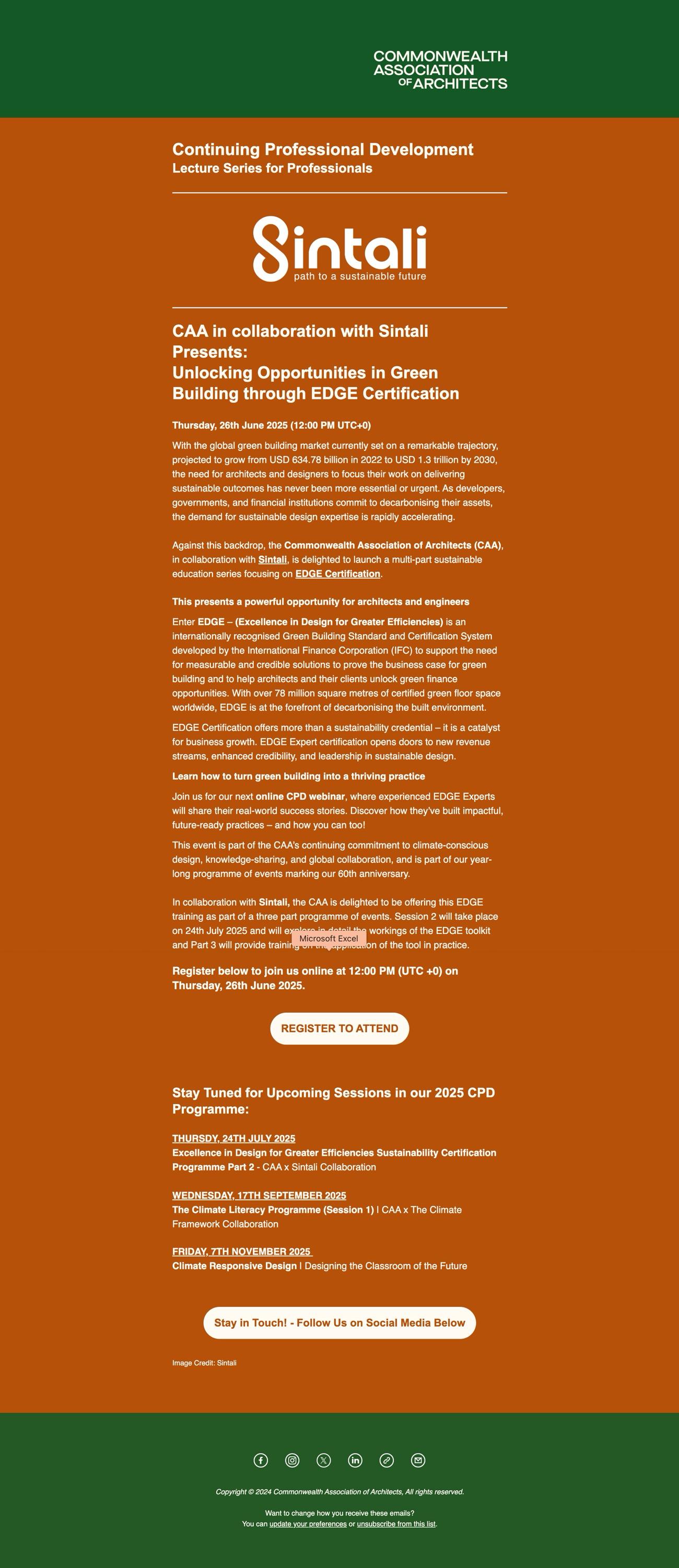


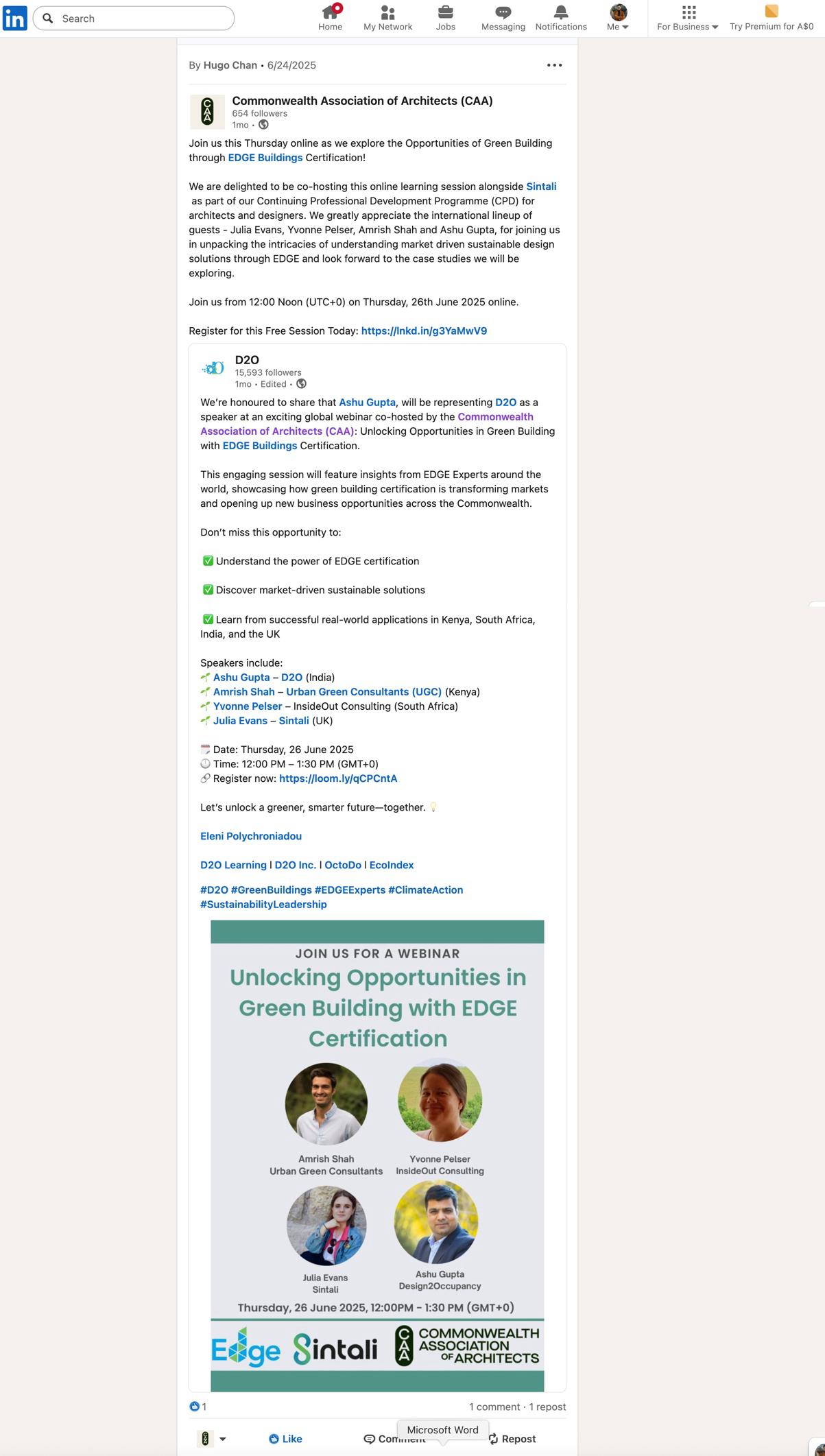
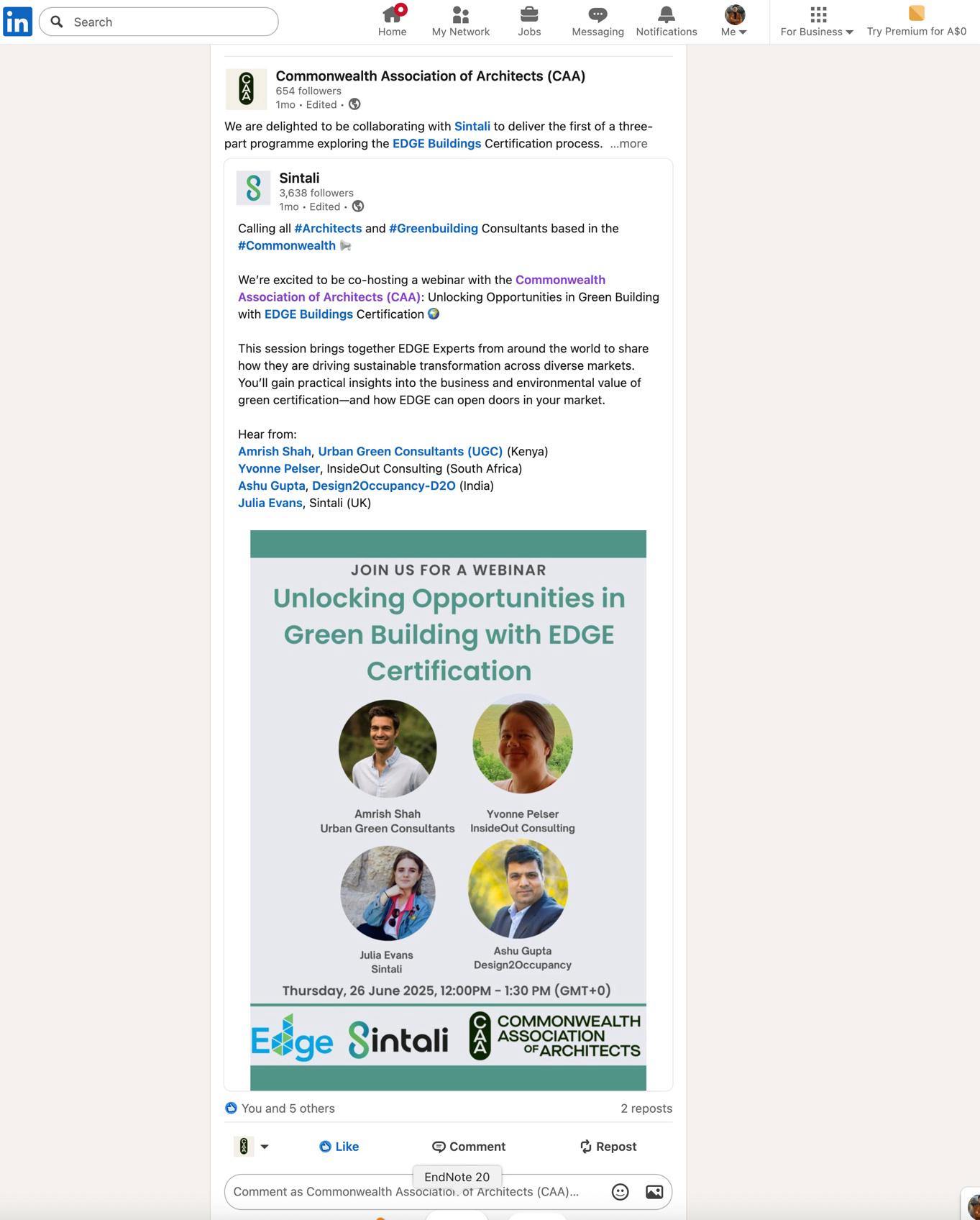
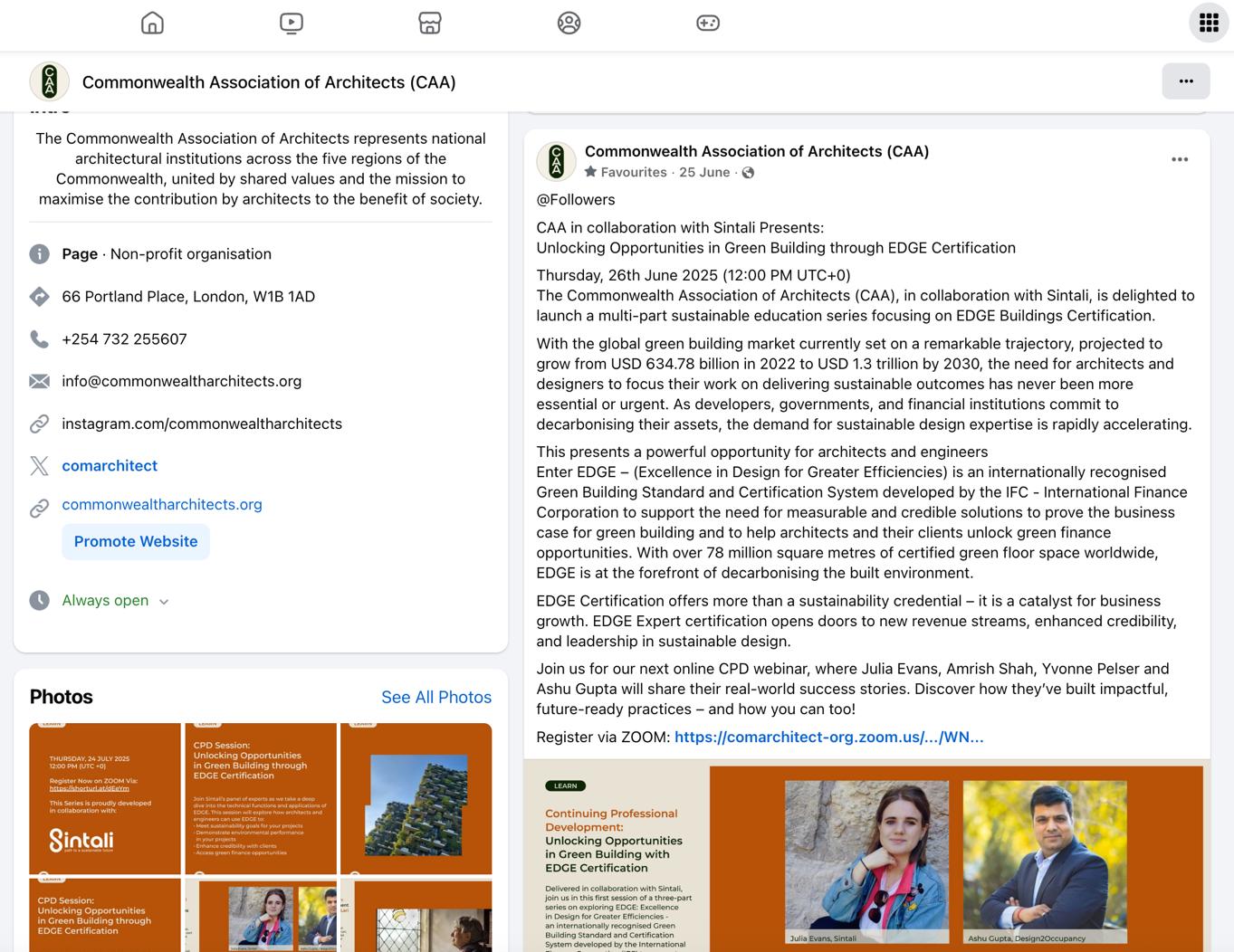
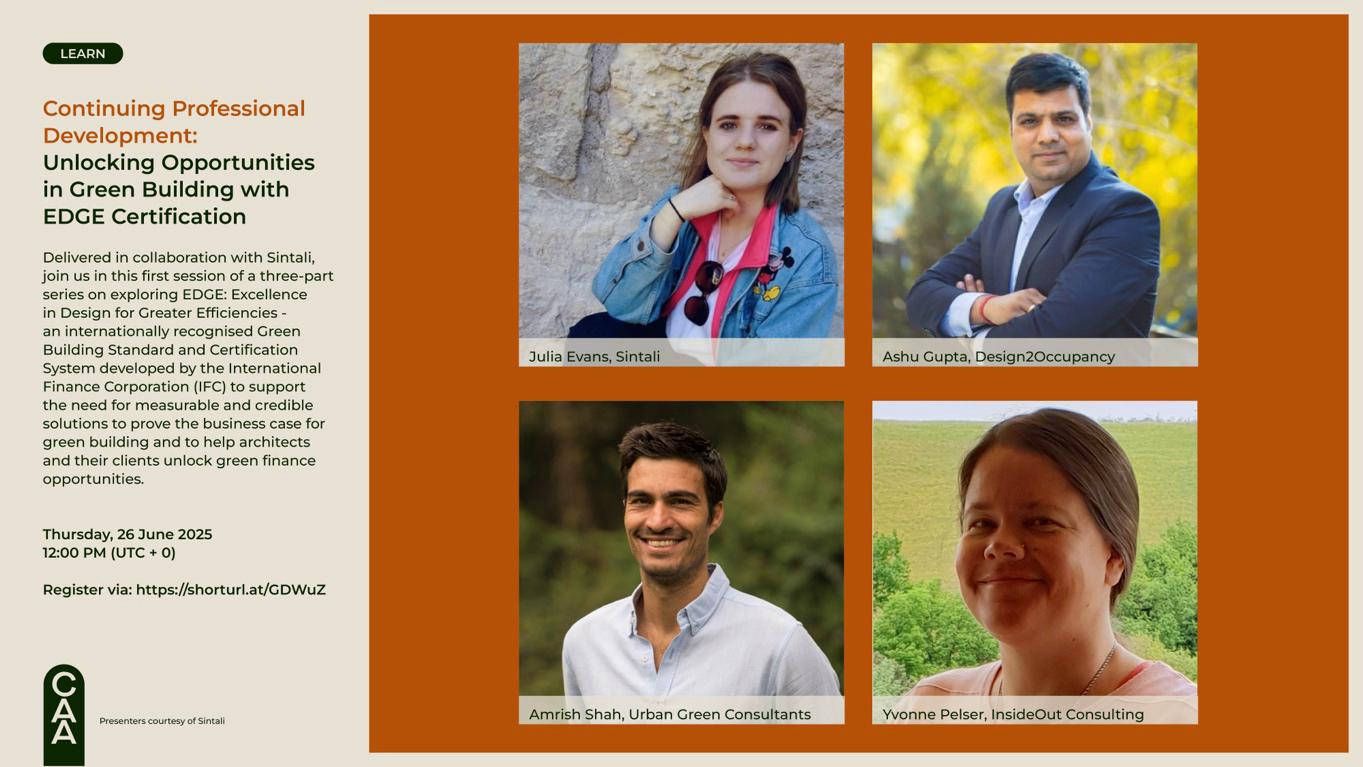
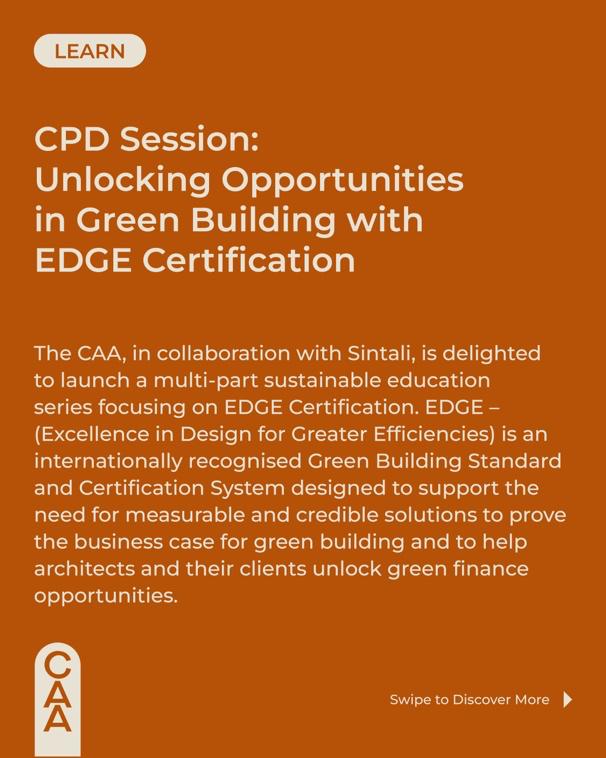
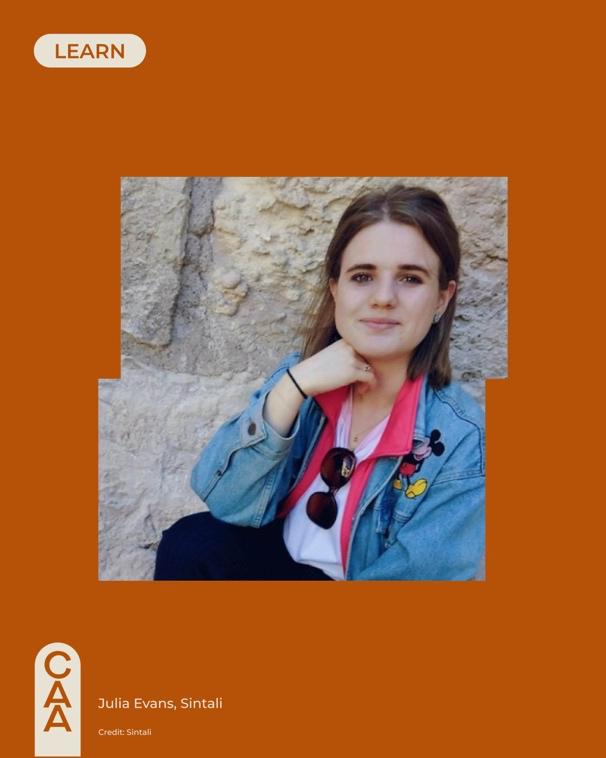
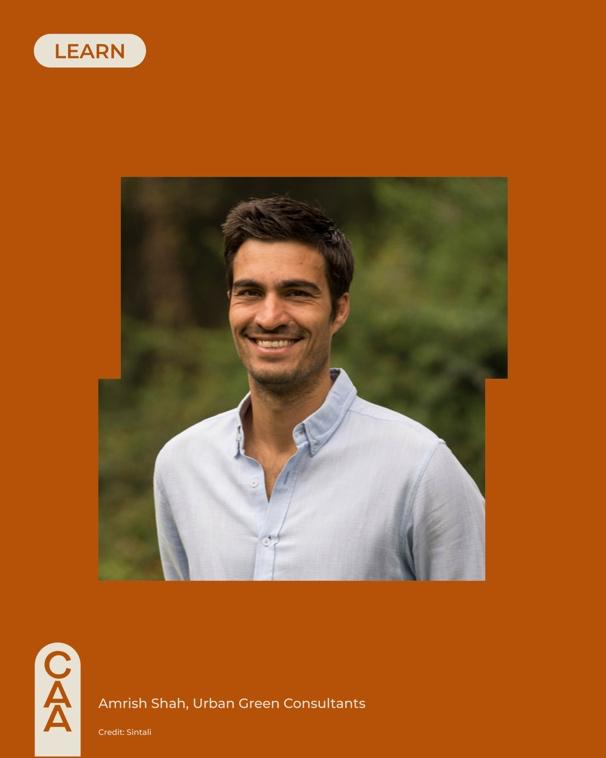
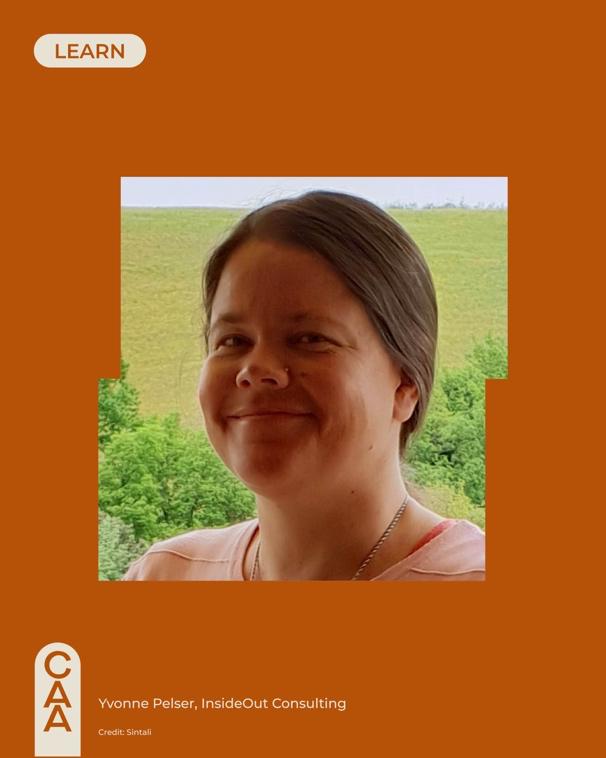

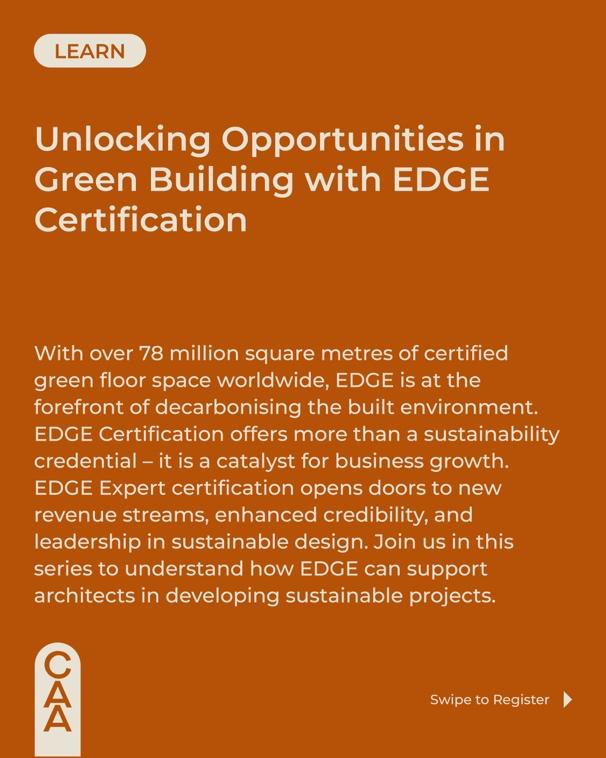

Caption
The CAA, in collaboration with Sintali, is delighted to launch a multi-part sustainable education series focusing on EDGE Certification. EDGE – (Excellence in Design for Greater Efficiencies) is an internationally recognised Green Building Standard and Certification System designed to support the need for measurable and credible solutions to prove the business case for green building and to help architects and their clients unlock green finance opportunities.
Join us on Thursday 26 June 2025 for this exciting session! #cpd #education #commonwealtharchitects #architects
Appendix E : Sample – Certificate of Participation
